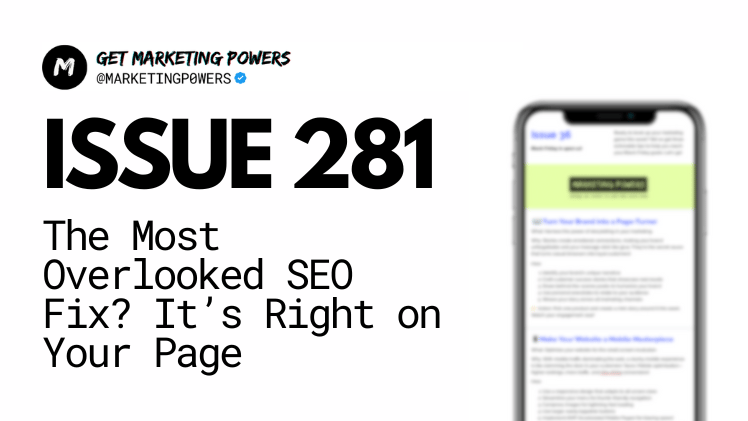- The Strategy of Marketing: Get Marketing Powers
- Posts
- Your Website Has the Traffic. Here’s How to Make It Convert.
Your Website Has the Traffic. Here’s How to Make It Convert.
On-Page SEO Tactics That Rank, Retain, and Convert

Hey there,
Let’s cut to it:
You might be missing out on massive organic growth…
Not because of poor content.
Not because of weak backlinks.
But because of what’s happening on your own pages.
That’s right - on-page SEO is still one of the highest-leverage, lowest-cost ways to boost your rankings, traffic quality, and conversion rate.
And yet… most businesses overlook it.
This week, we’re unpacking advanced, field-tested on-page SEO techniques that:
✅ Help your pages rank higher
✅ Make content easier to digest and trust
✅ Guide visitors toward conversion
Let’s turn your content into a ranking and revenue engine.
🚀 Growth Fix: Why On-Page SEO Is the Sleeping Giant
The Problem:
You’re putting in the effort:
✔️ You’re writing blogs
✔️ You’re targeting keywords
✔️ You’re building links
But results are flat:
❌ Rankings plateau after week 1
❌ Pages get impressions but no clicks
❌ Users bounce fast
❌ Traffic grows — conversions don’t
Why This Hurts Your Business:
Google isn’t ranking pages that aren’t clearly structured, intent-aligned, or optimised for humans.
And even if you get the traffic?
You’re likely losing it - fast!
On-page SEO connects discovery to engagement to action.
It’s not about more traffic.
It’s about the right traffic doing the right thing on the right page.
✅ The Fix:
Invest in high-impact on-page improvements. Structure, readability, metadata, internal linking, and trust signals - all mapped to how users and search engines experience your content.
A niche B2B SaaS had strong domain authority but poor organic traction. Their top pages:
Didn’t match search intent
Had walls of text with no subheadings
Buried CTAs at the bottom
Missed internal links and keyword clarity
They made 5 simple changes:
Rewrote title tags and meta descriptions using data from SERPs
Added H2s/H3s to guide skimmers
Inserted strategic internal links to core products
Updated content to include FAQs + schema
Moved CTAs to top and middle of page
Result?
📈 3x increase in organic traffic
📉 40% drop in bounce rate
💰 26% lift in conversions from organic visitors — within 60 days.
This is what on-page SEO should look like in 2025.
⚡ The Complete On-Page SEO Playbook: 7 Key Areas to Focus On
1️⃣ Map Your Content to User Intent (Not Just Keywords)
Why It Matters:
If your page doesn’t satisfy the why behind the query, it won’t rank - no matter how many keywords you include.
🔍 Types of Intent:
Informational: “What is CRM software?”
Navigational: “[Brand] pricing page”
Transactional: “Best CRM for small business”
🎯 Action Tip:
→ Google your target keyword.
→ Study the top 5 results: what type of content ranks?
→ Align your format and messaging accordingly.
Why It Matters:
Titles and descriptions = your content’s first impression.
They drive clicks, signal relevance, and set expectations.
🎯 Action Tip:
→ Front-load your primary keyword
→ Include an outcome or benefit
→ Keep titles <60 characters and metas <155
→ Test emotional vs. data-driven copy
3️⃣ Use Headings to Create a Clear Hierarchy
Why It Matters:
H1s, H2s, and H3s help both users and search engines understand your page’s structure — and flow.
🎯 Action Tip:
→ Use only one H1 per page
→ Break content into logical, skimmable sections
→ Use H2s for major themes, H3s for details or steps
Bonus: Structured content improves your chance of earning featured snippets.
4️⃣ Improve Readability and Scannability
Why It Matters:
Attention spans are short. A wall of text = instant bounce.
🎯 Action Tip:
→ Keep sentences <20 words
→ Use bullet points for steps or comparisons
→ Add visuals, pull quotes, bolding to guide the eye
→ Aim for an 8th-grade reading level (use Hemingway or Grammarly to check)
5️⃣ Add Strategic Internal Links
Why It Matters:
Internal links distribute authority and keep users (and crawlers) exploring.
🎯 Action Tip:
→ Link TO and FROM every high-value page
→ Use descriptive anchor text (not “click here”)
→ Avoid over-linking — 2–6 per 1,000 words is ideal
→ Create content hubs or topic clusters around core themes
6️⃣ Optimise for Engagement Signals
Why It Matters:
Time on page, bounce rate, and scroll depth all inform Google’s assessment of quality.
🎯 Action Tip:
→ Move CTAs higher on the page
→ Embed multimedia (images, videos, tools)
→ Add FAQ sections for long-tail queries
→ Use tools like Hotjar to analyse scroll/interaction behaviour
7️⃣ Keep Content Fresh and Comprehensive
Why It Matters:
Google favours updated, in-depth content that reflects evolving user needs.
🎯 Action Tip:
→ Audit top pages quarterly
→ Expand outdated content with new stats/examples
→ Add supporting content (FAQs, how-tos, checklists)
→ Use content decay tools like Animalz Revive or Google Search Console trend reports
✅ This Week’s To-Do List:
🔍 Audit 3 of your top content pages:
Are titles clear and click-worthy?
Are there at least 3+ internal links?
Does the page structure align with user intent?
📈 Refresh or expand content that hasn’t been updated in 6+ months
🔗 Create a simple internal linking map for key topics
📋 Build a reusable On-Page SEO Checklist for your content team
🚦 Use Google Search Console to find underperforming pages (impressions but low CTR) and prioritise those first
🎯 Bottom Line:
On-page SEO isn’t just about pleasing Google.
It’s about building content that’s easier to read, more helpful, more engaging and more likely to convert.
And it’s 100% within your control.
Fix your foundation this week and watch everything else get easier.
Talk soon!